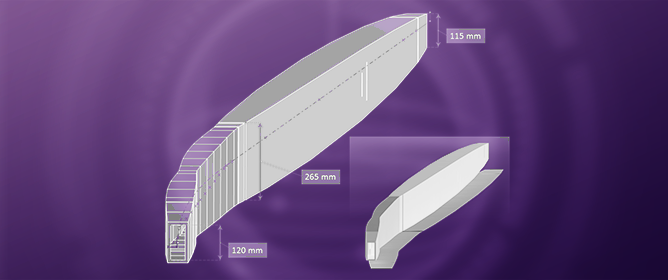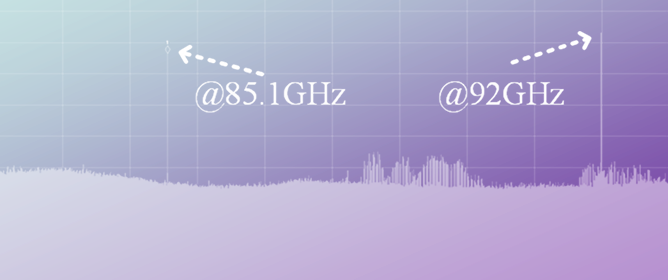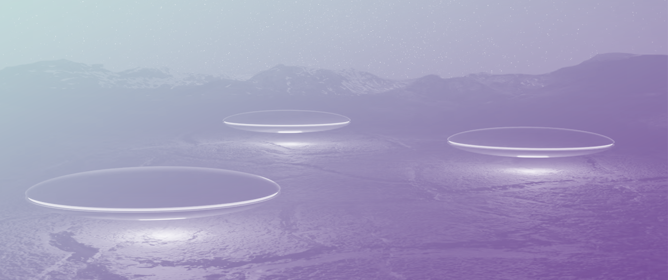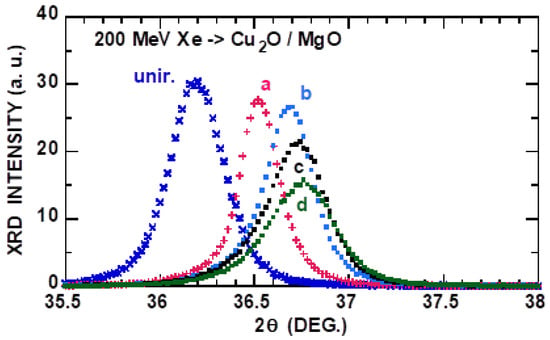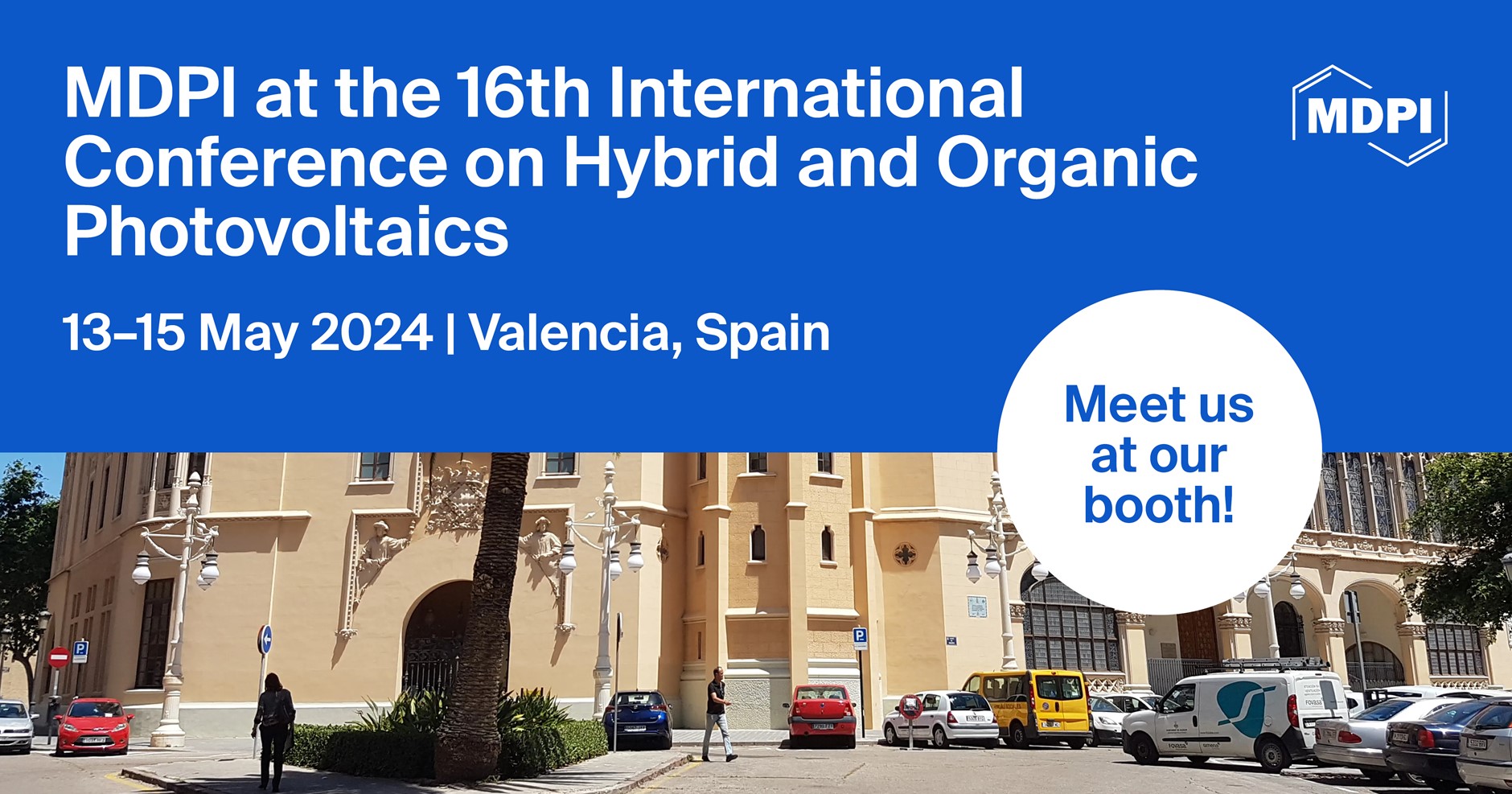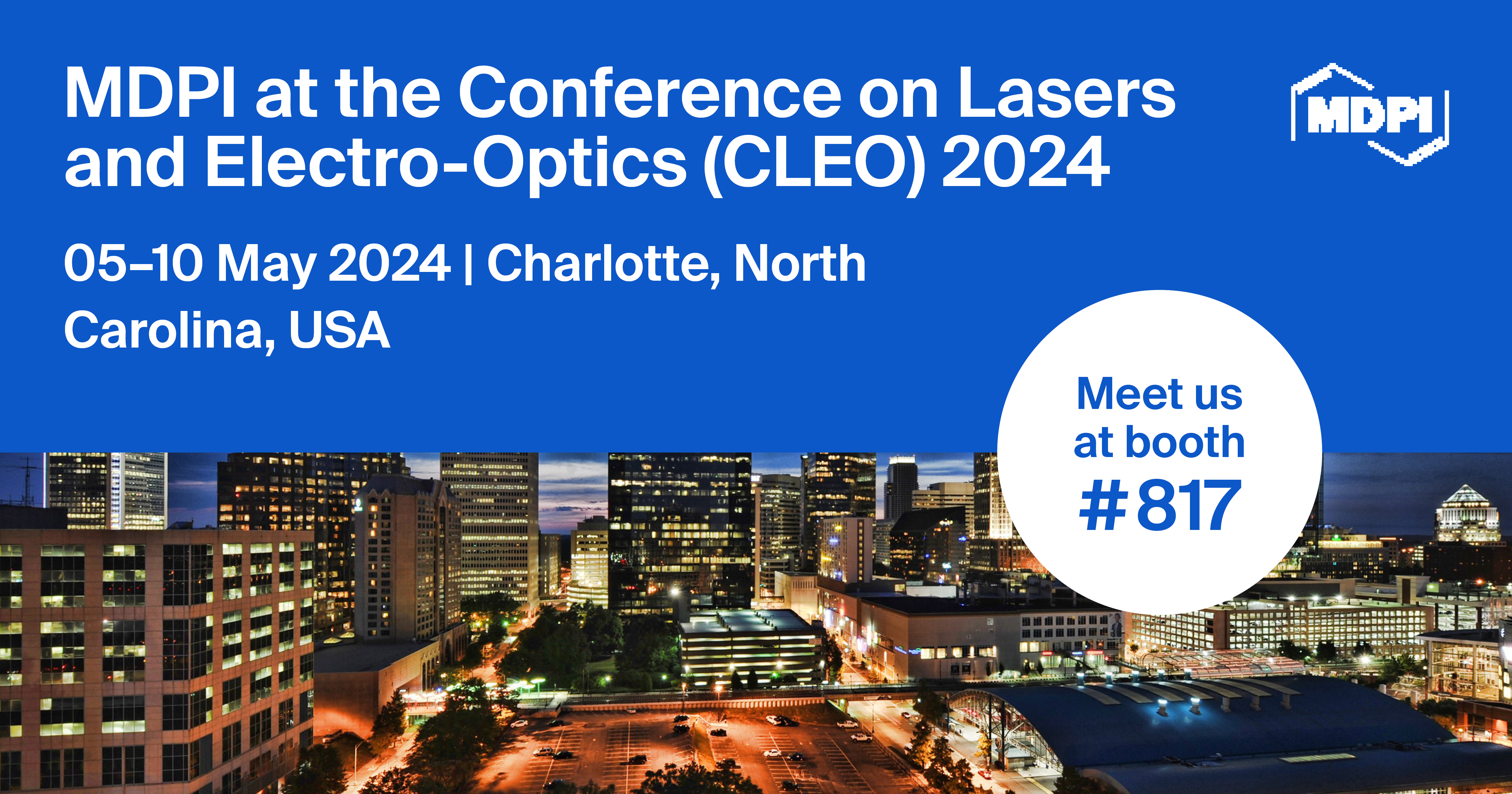Journal Description
Quantum Beam Science
Quantum Beam Science
is an international, peer-reviewed, open access journal on research derived from beam line facilities and related techniques published quarterly online by MDPI.
- Open Access— free for readers, with article processing charges (APC) paid by authors or their institutions.
- High Visibility: indexed within Scopus, ESCI (Web of Science), CAPlus / SciFinder, Inspec, Astrophysics Data System, and other databases.
- Journal Rank: CiteScore - Q2 (Nuclear and High Energy Physics)
- Rapid Publication: manuscripts are peer-reviewed and a first decision is provided to authors approximately 22 days after submission; acceptance to publication is undertaken in 5.5 days (median values for papers published in this journal in the second half of 2023).
- Recognition of Reviewers: reviewers who provide timely, thorough peer-review reports receive vouchers entitling them to a discount on the APC of their next publication in any MDPI journal, in appreciation of the work done.
Impact Factor:
1.4 (2022);
5-Year Impact Factor:
1.6 (2022)
Latest Articles
Modification of Cu Oxide and Cu Nitride Films by Energetic Ion Impact
Quantum Beam Sci. 2024, 8(2), 12; https://doi.org/10.3390/qubs8020012 - 10 Apr 2024
Abstract
►
Show Figures
We have investigated lattice disordering of cupper oxide (Cu2O) and copper nitride (Cu3N) films induced by high- and low-energy ion impact, knowing that the effects of electronic excitation and elastic collision play roles by these ions, respectively. For high-energy
[...] Read more.
We have investigated lattice disordering of cupper oxide (Cu2O) and copper nitride (Cu3N) films induced by high- and low-energy ion impact, knowing that the effects of electronic excitation and elastic collision play roles by these ions, respectively. For high-energy ion impact, degradation of X-ray diffraction (XRD) intensity per ion fluence or lattice disordering cross-section (YXD) fits to the power-law: YXD = (BXDSe)NXD, with Se and BXD being the electronic stopping power and a constant. For Cu2O and Cu3N, NXD is obtained to be 2.42 and 1.75, and BXD is 0.223 and 0.54 (kev/nm)−1. It appears that for low-energy ion impact, YXD is nearly proportional to the nuclear stopping power (Sn). The efficiency of energy deposition, YXD/Se, as well as Ysp/Se, is compared with YXD/Sn, as well as Ysp/Sn. The efficiency ratio RXD = (YXD/Se)/(YXD/Sn) is evaluated to be ~0.1 and ~0.2 at Se = 15 keV/nm for Cu2O and Cu3N, meaning that the efficiency of electronic energy deposition is smaller than that of nuclear energy deposition. Rsp = (Ysp/Se)/(Ysp/Sn) is evaluated to be 0.46 for Cu2O and 0.7 for Cu3N at Se = 15 keV/nm.
Full article
Open AccessArticle
Estimating Lung Volume Capacity from X-ray Images Using Deep Learning
by
Samip Ghimire and Santosh Subedi
Quantum Beam Sci. 2024, 8(2), 11; https://doi.org/10.3390/qubs8020011 - 28 Mar 2024
Abstract
►▼
Show Figures
Estimating lung volume capacity is crucial in clinical medicine, especially in disease diagnostics. However, the existing estimation methods are complex and expensive, which require experts to handle and consequently are more error-prone and time-consuming. Thus, developing an automatic measurement system without a human
[...] Read more.
Estimating lung volume capacity is crucial in clinical medicine, especially in disease diagnostics. However, the existing estimation methods are complex and expensive, which require experts to handle and consequently are more error-prone and time-consuming. Thus, developing an automatic measurement system without a human operator that is less prone to human error and, thus, more accurate has always been a prerequisite. The limitation of radiation dose and various medical conditions in technologies like computed tomography was also the primary concern in the past. Although qualitative prediction of lung volume may be a trivial task, designing clinically relevant and automated methods that effectively incorporate imaging data is a challenging problem. This paper proposes a novel multi-tasking-based automatic lung volume estimation method using deep learning that jointly learns segmentation and regression of volume estimation. The two networks, namely, segmentation and regression networks, are sequentially operated with some shared layers. The segmentation network segments the X-ray images, whose output is regressed by the regression network to determine the final lung volume. Besides, the dataset used in the proposed method is collected from three different secondary sources. The experimental results show that the proposed multi-tasking approach performs better than the individual networks. Further analysis of the multi-tasking approach with two different networks, namely, UNet and HRNet, shows that the network with HRNet performs better than the network with UNet with less volume estimation mean square error of 0.0010.
Full article
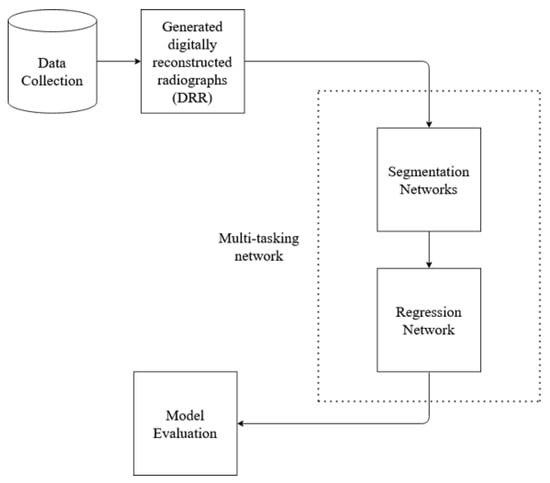
Figure 1
Open AccessReview
Lithium-Ion Batteries under the X-ray Lens: Resolving Challenges and Propelling Advancements
by
Mahdieh Samimi, Mehran Saadabadi and Hassan Hosseinlaghab
Quantum Beam Sci. 2024, 8(2), 10; https://doi.org/10.3390/qubs8020010 - 27 Mar 2024
Abstract
►▼
Show Figures
The quest for high-performance lithium-ion batteries (LIBs) is at the forefront of energy storage research, necessitating a profound understanding of intricate processes like phase transformations and thermal runaway events. This review paper explores the pivotal role of X-ray spectroscopies in unraveling the mysteries
[...] Read more.
The quest for high-performance lithium-ion batteries (LIBs) is at the forefront of energy storage research, necessitating a profound understanding of intricate processes like phase transformations and thermal runaway events. This review paper explores the pivotal role of X-ray spectroscopies in unraveling the mysteries embedded within LIBs, focusing on the utilization of advanced techniques for comprehensive insights. This explores recent advancements in in situ characterization tools, prominently featuring X-ray diffraction (XRD), X-ray tomography (XRT), and transmission X-ray microscopy (TXM). Each technique contributes to a comprehensive understanding of structure, morphology, chemistry, and kinetics in LIBs, offering a selective analysis that optimizes battery electrodes and enhances overall performance. The investigation commences by highlighting the indispensability of tracking phase transformations. Existing challenges in traditional methods, like X-ray absorption spectroscopy (XAS), become evident when faced with nanoscale inhomogeneities during the delithiation process. Recognizing this limitation, the review emphasizes the significance of advanced techniques featuring nanoscale resolution. These tools offer unprecedented insights into material structures and surface chemistry during LIB operation, empowering researchers to address the challenges posed by thermal runaway. Such insights prove critical in unraveling interfacial transport mechanisms and phase transformations, providing a roadmap for the development of safe and high-performance energy storage systems. The integration of X-ray spectroscopies not only enhances our understanding of fundamental processes within LIBs but also propels the development of safer, more efficient, and reliable energy storage solutions. In spite of those benefits, X-ray spectroscopies have some limitations in regard to studying LIBs, as referred to in this review.
Full article

Figure 1
Open AccessArticle
Development of a Time-Gated Epithermal Neutron Spectrometer for Resonance Absorption Measurements Driven by a High-Intensity Laser
by
Zechen Lan, Yasunobu Arikawa, Yuki Abe, Seyed Reza Mirfayzi, Alessio Morace, Takehito Hayakawa, Tianyun Wei and Akifumi Yogo
Quantum Beam Sci. 2024, 8(1), 9; https://doi.org/10.3390/qubs8010009 - 29 Feb 2024
Abstract
The advance of laser-driven neutron sources (LDNSs) has enabled neutron resonance spectroscopy to be performed with a single shot of a laser. In this study, we describe a detection system of epithermal (∼eV) neutrons especially designed for neutron resonance spectroscopy. A time-gated photomultiplier
[...] Read more.
The advance of laser-driven neutron sources (LDNSs) has enabled neutron resonance spectroscopy to be performed with a single shot of a laser. In this study, we describe a detection system of epithermal (∼eV) neutrons especially designed for neutron resonance spectroscopy. A time-gated photomultiplier tube (PMT) with a high cut-off ratio was introduced for epithermal neutron detection in a high-power laser experiment at the Institute of Laser Engineering, Osaka University. We successfully reduced the PMT response to the intense hard X-ray generated as a result of the interaction between laser light and the target material. A time-gated circuit was designed to turn off the response of the PMT during the laser pulse and resume recording the signal when neutrons arrive. The time-gated PMT was coupled with a 6Li glass scintillator, serving as a time-of-flight (TOF) detector to measure the neutron resonance absorption values of 182W and 109Ag in a laser-driven epithermal neutron generation experiment. The neutron resonance peaks at
(This article belongs to the Section High-Power Laser Physics)
►▼
Show Figures
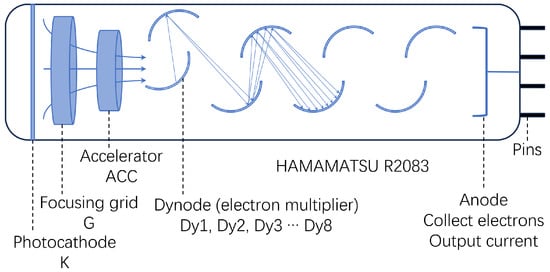
Figure 1
Open AccessArticle
New Ballistic Neutron Guide for the Time-of-Flight Spectrometer FOCUS at PSI
by
Fanni Juranyi, Masako Yamada, Christine Klauser, Lothar Holitzner and Uwe Filges
Quantum Beam Sci. 2024, 8(1), 8; https://doi.org/10.3390/qubs8010008 - 13 Feb 2024
Abstract
FOCUS is a direct-geometry cold neutron time-of-flight spectrometer at SINQ (PSI, CH). Its neutron guide was exchanged in 2019/2020 within the SINQ Upgrade project, while the rest of the instrument remained unchanged. The new guide provided a significant intensity increase across the whole
[...] Read more.
FOCUS is a direct-geometry cold neutron time-of-flight spectrometer at SINQ (PSI, CH). Its neutron guide was exchanged in 2019/2020 within the SINQ Upgrade project, while the rest of the instrument remained unchanged. The new guide provided a significant intensity increase across the whole spectrum, especially at short wavelengths, due to the more efficient transport and extended phase space of the transported neutrons. The practically available energy transfer range (at the neutron energy loss side) was increased to about 40 meV. The main reason for the intensity benefit at short incident wavelengths was the improved guide coating, whereas at long wavelengths it was the new ballistic shape. The interesting part of the guide is the “peanut shape” of the curved part in the horizontal plane. For this, we derived the analytical restriction on the geometry to avoid a direct line of sight from the source. The guide geometry and the supermirror coating were optimized using Mcoptimize, a particle swarm optimization routine employing Mcstas. Future ballistic neutron guides may profit from the presented approaches, optimization strategy, and results.
Full article
(This article belongs to the Special Issue New Trends in Neutron Instrumentation, 2nd Edition)
►▼
Show Figures
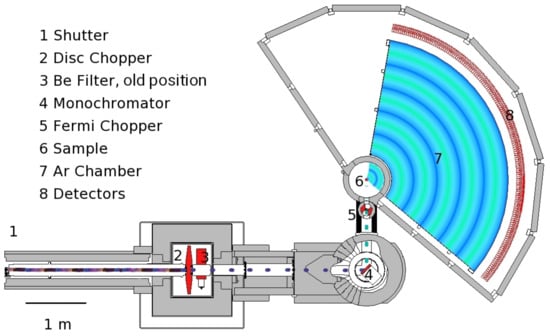
Figure 1
Open AccessArticle
Principal Preferred Orientation Evaluation of Steel Materials Using Time-of-Flight Neutron Diffraction
by
Pingguang Xu, Shuyan Zhang, Stefanus Harjo, Sven C. Vogel and Yo Tomota
Quantum Beam Sci. 2024, 8(1), 7; https://doi.org/10.3390/qubs8010007 - 17 Jan 2024
Abstract
Comprehensive information on in situ microstructural and crystallographic changes during the preparation/manufacturing processes of various materials is highly necessary to precisely control the microstructural morphology and the preferred orientation (or texture) characteristics for achieving an excellent strength–ductility–toughness balance in advanced engineering materials. In
[...] Read more.
Comprehensive information on in situ microstructural and crystallographic changes during the preparation/manufacturing processes of various materials is highly necessary to precisely control the microstructural morphology and the preferred orientation (or texture) characteristics for achieving an excellent strength–ductility–toughness balance in advanced engineering materials. In this study, in situ isothermal annealing experiments with cold-rolled 17Ni-0.2C (mass%) martensitic steel sheets were carried out by using the TAKUMI and ENGIN-X time-of-flight neutron diffractometers. The inverse pole figures based on full-profile refinement were extracted to roughly evaluate the preferred orientation features along three principal sample directions of the investigated steel sheets, using the General Structure Analysis System (GSAS) software with built-in generalized spherical harmonic functions. The consistent rolling direction (RD) inverse pole figures from TAKUMI and ENGIN-X confirmed that the time-of-flight neutron diffraction has high repeatability and statistical reliability, revealing that the principal preferred orientation evaluation of steel materials can be realized through 90° TD ➜ ND (transverse direction ➜ normal direction) rotation of the investigated specimen on the sample stage during two neutron diffraction experiments. Moreover, these RD, TD, and ND inverse pole figures before and after the in situ experiments were compared with the corresponding inverse pole figures recalculated from the MUSASI-L complete pole figure measurement and the HIPPO in situ microstructure evaluation, respectively. The similar orientation distribution characteristics suggested that the principal preferred orientation evaluation method can be applied to the in situ microstructural evolution of bulk orthorhombic materials and spatially resolved principal preferred orientation mappings of large engineering structure parts.
Full article
(This article belongs to the Special Issue Analysis of Strain, Stress and Texture with Quantum Beams, 2nd Edition)
►▼
Show Figures
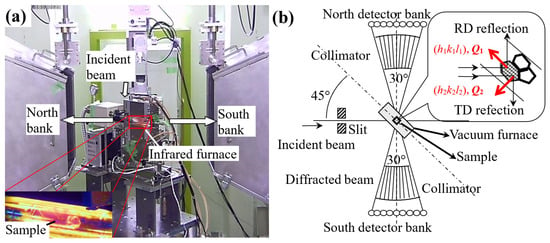
Figure 1
Open AccessArticle
Spectral Characteristics of Polarization Radiation in the Water Window Range
by
M. V. Shevelev, A. S. Konkov, S. R. Uglov, B. A. Alekseev and Yu. M. Cherepennikov
Quantum Beam Sci. 2024, 8(1), 6; https://doi.org/10.3390/qubs8010006 - 15 Jan 2024
Abstract
The high-intensity and monochromatic radiation sources in the water window spectral range are desirable for many applications. One of the potential candidates of soft X-ray sources is polarization radiation produced by a charged particle passing through a thin foil. In the soft X-ray
[...] Read more.
The high-intensity and monochromatic radiation sources in the water window spectral range are desirable for many applications. One of the potential candidates of soft X-ray sources is polarization radiation produced by a charged particle passing through a thin foil. In the soft X-ray range near the absorption edges of a target material, the real part of dielectric permittivity can exceed unity, and the Tamm–Frank criterion is fulfilled. Thus, two types of radiation are produced: transition and Cherenkov radiation. In this report, we theoretically investigated the spectral characteristics of radiation produced in both cases when the Tamm–Frank criterion is met or not met. We showed the dependences of the spectrum as a function of thickness and the incidence angle. To describe the properties of polarization radiation and the complex dielectric permittivity, the polarization current approach and Henke’s model were used, respectively.
Full article
(This article belongs to the Special Issue Quantum Beam Science: Feature Papers 2023)
►▼
Show Figures
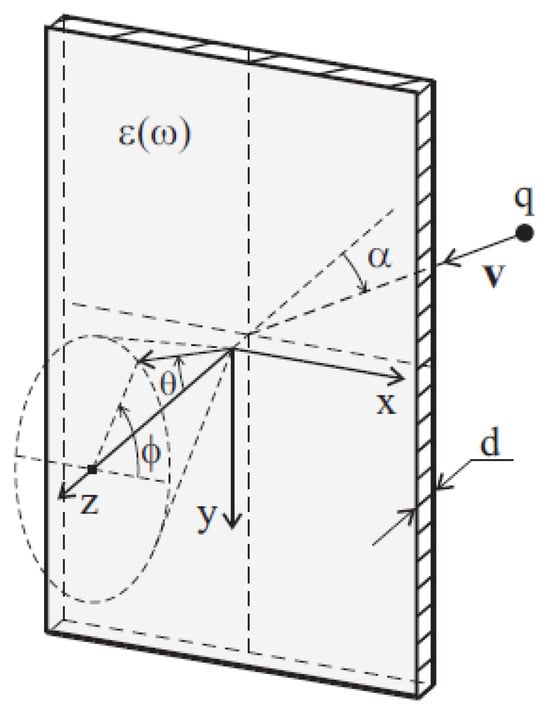
Figure 1
Open AccessArticle
A Platform for Laser-Driven Ion Sources Generated with Nanosecond Laser Pulses in the Intensity Range of 1013–1015 W/cm2
by
L. Giuffrida, V. Istokskaia, A. Picciotto, V. Kantarelou, M. Barozzi, R. Dell`Anna, M. Divoky, O. Denk, D. Giubertoni, F. Grepl, A. Hadjikyriacou, M. Hanus, J. Krasa, M. Kucharik, T. Levato, P. Navratil, J. Pilar, F. Schillaci, S. Stancek, M. Tosca, M. Tryus, A. Velyhan, A. Lucianetti, T. Mocek and D. Margaroneadd
Show full author list
remove
Hide full author list
Quantum Beam Sci. 2024, 8(1), 5; https://doi.org/10.3390/qubs8010005 - 10 Jan 2024
Abstract
►▼
Show Figures
An experimental platform for laser-driven ion (sub-MeV) acceleration and potential applications was commissioned at the HiLASE laser facility. The auxiliary beam of the Bivoj laser system operating at a GW level peak power (~10 J in 5–10 ns) and 1–10 Hz repetition rate
[...] Read more.
An experimental platform for laser-driven ion (sub-MeV) acceleration and potential applications was commissioned at the HiLASE laser facility. The auxiliary beam of the Bivoj laser system operating at a GW level peak power (~10 J in 5–10 ns) and 1–10 Hz repetition rate enabled a stable production of high-current ion beams of multiple species (Al, Ti, Fe, Si, Cu, and Sn). The produced laser–plasma ion sources were fully characterized against the laser intensity on the target (1013–1015 W/cm2) by varying the laser energy, focal spot size, and pulse duration. The versatility and tuneability of such high-repetition-rate laser–plasma ion sources are of potential interest for user applications. Such a statistically accurate study was facilitated by the large amount of data acquired at the high repetition rate (1–10 Hz) provided by the Bivoj laser system.
Full article
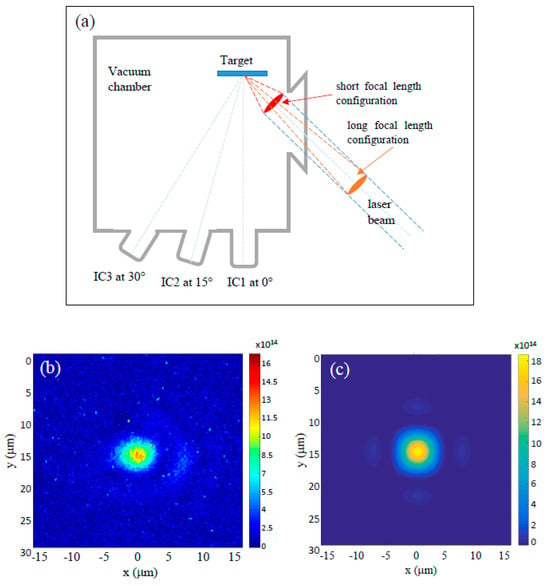
Figure 1
Open AccessReview
Nuclear Physics Opportunities at European Small-Scale Facilities
by
Jelena Vesić and Matjaž Vencelj
Quantum Beam Sci. 2024, 8(1), 4; https://doi.org/10.3390/qubs8010004 - 29 Dec 2023
Abstract
►▼
Show Figures
Small-scale facilities play a significant role in the landscape of nuclear physics research in Europe. They address a wide range of fundamental questions and are essential for teaching and training personnel in accelerator technology and science, providing them with diverse skill sets, complementary
[...] Read more.
Small-scale facilities play a significant role in the landscape of nuclear physics research in Europe. They address a wide range of fundamental questions and are essential for teaching and training personnel in accelerator technology and science, providing them with diverse skill sets, complementary to large projects. The current status and perspectives of nuclear physics research at small-scale facilities in Europe will be given.
Full article
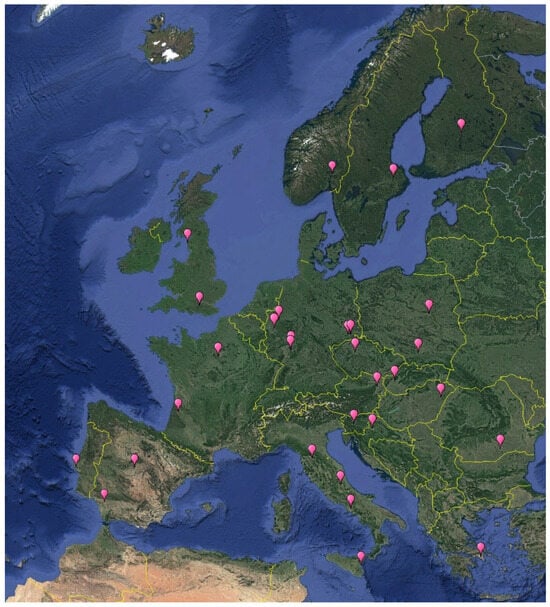
Figure 1
Open AccessArticle
Helical Electron Beam Status Online Evaluation for Magnetron Injection Gun
by
Wei Jiang, Chaoxuan Lu, Binyang Han, Boxin Dai, Qiang Zheng, Guo Liu, Jianxun Wang and Yong Luo
Quantum Beam Sci. 2024, 8(1), 3; https://doi.org/10.3390/qubs8010003 - 29 Dec 2023
Abstract
The magnetron injection gun (MIG) is an essential component of the gyrotron traveling wave tube (gyro-TWT). Although the electron beam status influences the performance of the device, it cannot be measured directly in the experiment. An online evaluation module (OEM) for the experiment
[...] Read more.
The magnetron injection gun (MIG) is an essential component of the gyrotron traveling wave tube (gyro-TWT). Although the electron beam status influences the performance of the device, it cannot be measured directly in the experiment. An online evaluation module (OEM) for the experiment is developed to calculate the instant beam parameters of MIG. The OEM, by reconstructing the geometry of the MIG and related magnetic field distribution, can obtain the electron beam status under the operating parameters through the online simulation. The beam velocity spread of thermal emission with instant temperature and surface roughness are also considered. The validation is done in a W-band gyro-TWT, and the beam performance is evaluated in the experiment. With a pitch factor of 1.06 electron beam, the velocity spread affected by the electric-magnetic mismatch, thermal emission, and roughness is 1.00%, 0.56%, and 0.43%, respectively. The other beam parameters are also presented in the developed module. The OEM could guide and accelerate the testing process and ensure the safe and stable operation of the device.
Full article
(This article belongs to the Special Issue New Challenges in Electron Beams)
►▼
Show Figures
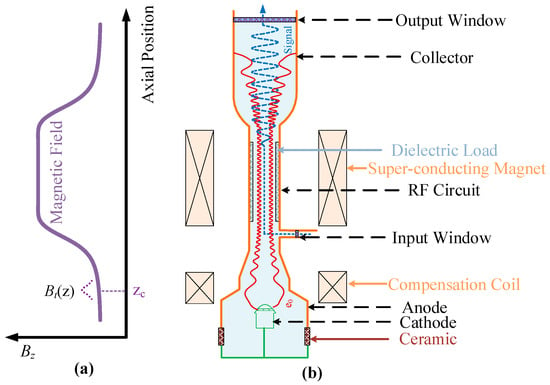
Figure 1
Open AccessArticle
Double-Relief Silver Coins Minted in the Greek Colonies (444–390/340–280/270 BC) of Southern Italy Analysed by XRF
by
Jessica Brocchieri, Rosa Vitale and Carlo Sabbarese
Quantum Beam Sci. 2024, 8(1), 2; https://doi.org/10.3390/qubs8010002 - 25 Dec 2023
Abstract
►▼
Show Figures
A sample of 18 double-relief coins from different poleis of Magna Graecia and ancient Italy has been analysed using a handheld XRF spectrometer directly inside the Museo Provinciale Campano (Capua, Italy). The data analysis shows that (i) the main elements are Ag and
[...] Read more.
A sample of 18 double-relief coins from different poleis of Magna Graecia and ancient Italy has been analysed using a handheld XRF spectrometer directly inside the Museo Provinciale Campano (Capua, Italy). The data analysis shows that (i) the main elements are Ag and Cu, indicating that the coins are of high fineness (average Ag 95.7%), (ii) trace elements can help to characterise the coins, (iii) a superficial chemically altered layer (corrosion) is absent, (iv) the values of ratio Ag Kα/Lα evidence the presence of an enrichment layer on the surface of silver or subaerata in some coins. Multivariate statistical analysis and graph analysis allowed the coins to be assigned to different groups with the highest possible accuracy on the basis of the chemical data obtained and models to be constructed to classify the coins according to their historical periods.
Full article

Figure 1
Open AccessArticle
Stress Measurement of Stainless Steel Piping Welds by Complementary Use of High-Energy Synchrotron X-rays and Neutrons
by
Yasufumi Miura, Kenji Suzuki, Satoshi Morooka and Takahisa Shobu
Quantum Beam Sci. 2024, 8(1), 1; https://doi.org/10.3390/qubs8010001 - 22 Dec 2023
Abstract
Probabilistic fracture mechanics (PFM) is increasingly recognized as a viable approach for evaluating the structural integrity of nuclear components, such as piping, primarily affected by stress corrosion cracking (SCC). PFM analysis requires several input parameters, among which welding residual stress is critically important
[...] Read more.
Probabilistic fracture mechanics (PFM) is increasingly recognized as a viable approach for evaluating the structural integrity of nuclear components, such as piping, primarily affected by stress corrosion cracking (SCC). PFM analysis requires several input parameters, among which welding residual stress is critically important due to its significant influence on SCC initiation and propagation. Recently, a novel technique involving a double-exposure method (DEM) utilizing synchrotron X-rays was introduced as an effective means for measuring welding residual stress with high spatial resolution. In this paper, we applied DEM to assess the residual stress of a plate specimen, which was extracted from a welded pipe through electrical discharge machining. Consequently, detailed stress maps under a plane stress state were generated. Additionally, the residual stress distributions in the welded pipe under a triaxial stress state were evaluated using neutron diffraction. Based on these findings, we proposed a methodology to acquire detailed stress maps of welded pipes by combining high-energy synchrotron X-rays and neutron diffraction.
Full article
(This article belongs to the Special Issue Analysis of Strain, Stress and Texture with Quantum Beams, 2nd Edition)
►▼
Show Figures
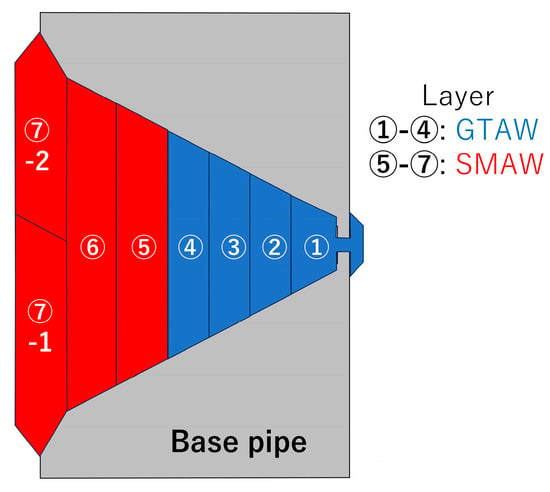
Figure 1
Open AccessBrief Report
Cable Robots as Conventional Linear Stage Alternatives for the Investigation of Complex-Shaped Objects via Macroscopic X-ray Fluorescence Imaging
by
Matthias Alfeld, Philipp Tempel and Volkert van der Wijk
Quantum Beam Sci. 2023, 7(4), 37; https://doi.org/10.3390/qubs7040037 - 21 Nov 2023
Abstract
The acquisition of elemental and chemical distribution images on the surface of cultural heritage objects has provided us new insights into our past. The techniques commonly employed, such as macroscopic X-ray fluorescence imaging (MA-XRF), in general require pointwise or whisk-broom scanning of an
[...] Read more.
The acquisition of elemental and chemical distribution images on the surface of cultural heritage objects has provided us new insights into our past. The techniques commonly employed, such as macroscopic X-ray fluorescence imaging (MA-XRF), in general require pointwise or whisk-broom scanning of an object under constant measurement geometry for optimal results. Most scanners in this field use stacked linear motorized stages, which are a proven solution for 2D sample positioning. Instead of these serial systems, we propose the use of a parallel cable robot to position the measurement head relative to the object investigated. In this article, we illustrate the significance of the issue and present our own cable robot prototype and test its capabilities, but also discuss the current shortcomings of the concept. With this, we demonstrate the potential of cable robots as platforms for MA-XRF and similar imaging techniques.
Full article
(This article belongs to the Special Issue New Advances in Macro X-ray Fluorescence Applications)
►▼
Show Figures
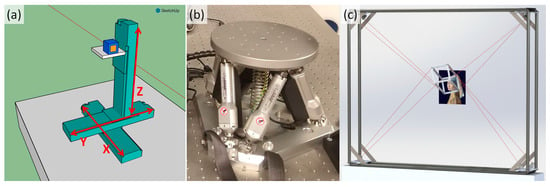
Figure 1
Open AccessArticle
Chromium–Aluminum Coatings for Oxidation Protection of Titanium–Aluminum Intermetallic Alloys
by
Almaz Nazarov, Alexey Maslov, Elena Korznikova and Kamil Ramazanov
Quantum Beam Sci. 2023, 7(4), 36; https://doi.org/10.3390/qubs7040036 - 20 Nov 2023
Abstract
This article explores the utilization of cathodic-arc deposition Cr-Al overlay coatings as oxidation protection for Ti-Al-Nb intermetallic alloys. The primary objective is to investigate PVD Al-Cr coatings deposited via cathodic-arc deposition without subsequent vacuum annealing. The microstructure, phase, and chemical composition of the
[...] Read more.
This article explores the utilization of cathodic-arc deposition Cr-Al overlay coatings as oxidation protection for Ti-Al-Nb intermetallic alloys. The primary objective is to investigate PVD Al-Cr coatings deposited via cathodic-arc deposition without subsequent vacuum annealing. The microstructure, phase, and chemical composition of the coatings were characterized using scanning electron microscopy, energy-dispersive X-ray spectroscopy, and X-ray diffraction analysis. Isothermal exposure of samples in a laboratory air furnace was conducted, revealing the efficacy of Cr-Al coatings in protecting the Ti49-11Al-40Nb-1.5Zr-0.75V-0.75Mo-0.2Si (mass%) intermetallic alloy VTI-4 against oxidation. The findings highlight that the as-deposited coatings possess a layered structure and contain Al-Cr intermetallics. Post-exposure to the furnace without prior vacuum annealing results in coatings exhibiting a porous microstructure, raising concerns regarding oxidation protection. This investigation of Cr-Al coatings on a VTI-4 alloy substrate yields valuable insights into their nanolaminate structure and challenges associated with aluminum droplet fractions. The proposed additional vacuum heat treatment at 650 °C for 500 h effectively homogenizes the coating, leading to predominant Cr2Al and Ti-Al phases. Additionally, the formation of diffusion layers at the “coating–substrate” interface and the presence of oxide barriers contribute to the coatings’ heat resistance. Our research introduces possibilities for tailoring coating properties for specific high-temperature applications in aerospace, energy, or industrial contexts. Further refinement of the heat treatment process offers the potential for developing advanced coatings with enhanced performance characteristics.
Full article
(This article belongs to the Special Issue Quantum Beam Science: Feature Papers 2023)
►▼
Show Figures
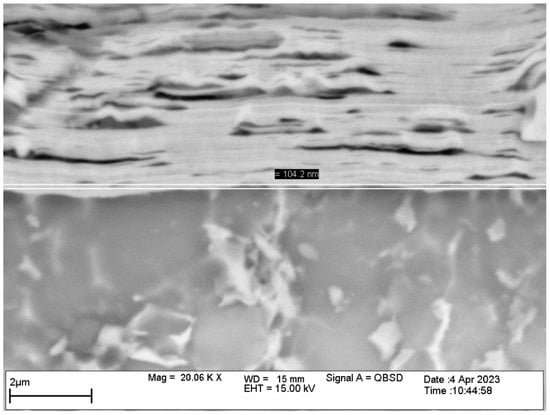
Figure 1
Open AccessArticle
Identifying the Spin-Incoherent Contribution to Quasielastic Neutron Scattering with a Cold Triple-Axis Spectrometer
by
Andrew G. Manning, Shinichiro Yano, Sojeong Kim, Won Bo Lee, Soo-Hyung Choi and Nicolas R. de Souza
Quantum Beam Sci. 2023, 7(4), 35; https://doi.org/10.3390/qubs7040035 - 13 Nov 2023
Cited by 1
Abstract
Polarisation analysis for neutron scattering experiments is a powerful tool suitable for a wide variety of studies, including soft-matter samples which have no bulk magnetic behaviour and/or a significant hydrogen content. Here, we describe a method to leverage the versatility and spin-polarisation capabilities
[...] Read more.
Polarisation analysis for neutron scattering experiments is a powerful tool suitable for a wide variety of studies, including soft-matter samples which have no bulk magnetic behaviour and/or a significant hydrogen content. Here, we describe a method to leverage the versatility and spin-polarisation capabilities of a cold triple-axis spectrometer to perform a measurement to separate coherent and incoherent neutron scattering for a non-magnetic sample in the quasielastic neutron scattering (QENS) regime. Such measurements are complementary to unpolarised QENS measurements, which may typically be performed on a backscattering or time-of-flight spectrometer instrument where polarisation analysis can be significantly more difficult to achieve, and utilise the strengths of each type of instrument.
Full article
(This article belongs to the Special Issue Quantum Beam Science: Feature Papers 2023)
►▼
Show Figures
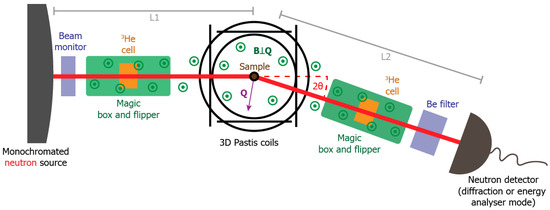
Figure 1
Open AccessArticle
Measurement of Mechanical Behavior of 11B-Enriched MgB2 Wire Using a Pulsed Neutron Source
by
Shutaro Machiya, Kozo Osamura, Yoshimitsu Hishinuma, Hiroyasu Taniguchi, Stefanus Harjo and Takuro Kawasaki
Quantum Beam Sci. 2023, 7(4), 34; https://doi.org/10.3390/qubs7040034 - 31 Oct 2023
Cited by 1
Abstract
MgB2 represents a hexagonal superconductive material renowned for its straightforward composition, which has facilitated the development of cost-effective practical wires. Its capacity to function at temperatures as low as liquid hydrogen (LH2) has made it a prominent candidate as wire
[...] Read more.
MgB2 represents a hexagonal superconductive material renowned for its straightforward composition, which has facilitated the development of cost-effective practical wires. Its capacity to function at temperatures as low as liquid hydrogen (LH2) has made it a prominent candidate as wire material for the coils of next-generation fusion reactors. Much like other superconducting wires, a prevalent issue arises when these wires are employed in coils, wherein electromagnetic forces induce tensile stress and strain within the wire. This, in turn, diminishes the critical current, which is the maximum current capable of flowing within the generated magnetic field and strain. The techniques and methods for accurately measuring the actual strain on the filaments are of paramount importance. While strain measurements have been conducted with synchrotron radiation and neutrons for other practical wires in the past, no such measurements have been undertaken for MgB2. Presumably, this lack of measurement is attributed to its relatively greater thickness, making it less suitable for synchrotron radiation measurements. Additionally, the high absorption cross-section of the included boron-10 poses challenges in obtaining elastic scattering data for neutron measurements. In response, we fabricated a wire enriched with boron-11, an isotope with a smaller neutron absorption cross-section. We then embarked on the endeavor to measure its strain under tensile loading using pulsed neutrons. Consequently, we succeeded in obtaining changes in the lattice constant under tensile loading through Rietveld analysis. This marks the inaugural instance of strain measurement on an MgB2 filament, signifying a significant milestone in superconductivity research.
Full article
(This article belongs to the Special Issue Analysis of Strain, Stress and Texture with Quantum Beams, 2nd Edition)
►▼
Show Figures
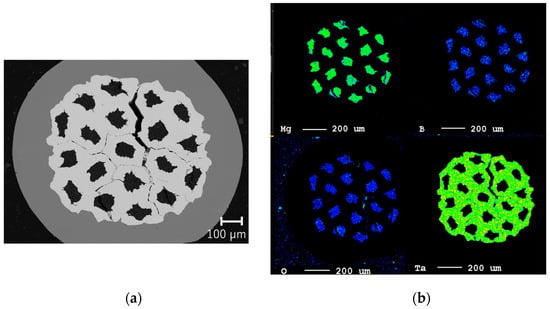
Figure 1
Open AccessArticle
Collective Acceleration of Helium Ions from Its Residual Atmosphere in a Luce Diode
by
Vladislav Ryzhkov, Mikhail Zhuravlev and Gennady Remnev
Quantum Beam Sci. 2023, 7(4), 33; https://doi.org/10.3390/qubs7040033 - 24 Oct 2023
Abstract
►▼
Show Figures
The collective acceleration of helium ions from its residual atmosphere in the Luce diode was studied at helium pressures from 0.13 to 0.23 Pa. The energy of accelerated ions was determined from the drift velocity of the virtual cathode accelerating the ions. The
[...] Read more.
The collective acceleration of helium ions from its residual atmosphere in the Luce diode was studied at helium pressures from 0.13 to 0.23 Pa. The energy of accelerated ions was determined from the drift velocity of the virtual cathode accelerating the ions. The number of 4He was determined by radioactivities of 13N and 30P induced in h-BN and Al targets via the nuclear reactions 10B(α,n)13N and 27Al(α,n)30P. The efficiency of capturing 4He ions in collective acceleration from the residual helium atmosphere was estimated as 0.25%. With increasing helium pressure above 0.15 Pa, the energy of the main ion group noticeably decreased to 0.46 MeV/amu compared to the acceleration from a usual residual atmosphere (~0.6 MeV/amu); however, the probability of ion acceleration to a specific energy of up to 1.57 MeV/amu increased significantly. Such increases in the ion energy were accompanied by the appearance of the signal of the second virtual cathode 7–9 ns after the appearance of the first virtual cathode.
Full article

Figure 1
Open AccessArticle
Stress Evaluation Method by Neutron Diffraction for HCP-Structured Magnesium Alloy
by
Stefanus Harjo, Wu Gong and Takuro Kawasaki
Quantum Beam Sci. 2023, 7(4), 32; https://doi.org/10.3390/qubs7040032 - 13 Oct 2023
Cited by 1
Abstract
Tensile deformation in situ neutron diffraction of an extruded AZ31 alloy was performed to validate conventional procedures and to develop new procedures for stress evaluation from lattice strains by diffraction measurements of HCP-structured magnesium alloys. Increases in the lattice strains with respect to
[...] Read more.
Tensile deformation in situ neutron diffraction of an extruded AZ31 alloy was performed to validate conventional procedures and to develop new procedures for stress evaluation from lattice strains by diffraction measurements of HCP-structured magnesium alloys. Increases in the lattice strains with respect to the applied true stress after yielding largely vary among [hk.l] grains. Some [hk.l] grains have little or no increase in lattice strain, making it difficult to use the conventional procedures to determine the average phase strain by using lattice constants or by averaging several lattice strains. The newly proposed procedure of stress evaluation from the lattice strains shows very high accuracy and reliability by weighting the volume fraction of [hk.l] grains and evaluating them in many [hk.l] orientations in addition to multiplication by the diffraction elastic constant. When multiple hk.l peaks cannot be obtained simultaneously, we recommend to use the 12.1 peak for stress evaluation. The lattice strain value evaluated from the 12.1 peak shows a good linear relationship with the applied true stress for the whole deformation region.
Full article
(This article belongs to the Special Issue Analysis of Strain, Stress and Texture with Quantum Beams, 2nd Edition)
►▼
Show Figures
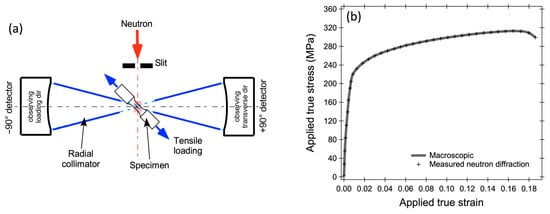
Figure 1
Open AccessArticle
Influence of Gate Depletion Layer Width on Radiation Resistance of Silicon Carbide Junction Field-Effect Transistors
by
Akinori Takeyama, Takahiro Makino, Yasunori Tanaka, Shin-Ichiro Kuroki and Takeshi Ohshima
Quantum Beam Sci. 2023, 7(4), 31; https://doi.org/10.3390/qubs7040031 - 11 Oct 2023
Abstract
Silicon carbide junction field-effect transistors (SiC JFETs) are promising candidates as devices applicable to radiation conditions, such as the decommissioning of nuclear facilities or the space environment. We investigate the origin of the threshold volage (Vth) shift and hysteresis of
[...] Read more.
Silicon carbide junction field-effect transistors (SiC JFETs) are promising candidates as devices applicable to radiation conditions, such as the decommissioning of nuclear facilities or the space environment. We investigate the origin of the threshold volage (Vth) shift and hysteresis of differently structured SiC JFETs. A large positive Vth shift and hysteresis are observed for a depletion-type JFET with a larger depletion layer width. With changing the sweep range of the gate voltage and depletion width, the Vth shift was positively proportional to the difference between the channel depth and depletion width (channel depth–gate depletion width). By illuminating the sub-band gap light, the Vth of the irradiated depletion JFETs recovers close to nonirradiated ones, while a smaller shift and hysteresis are observed for the enhancement type with a narrower width. It can be interpreted that positive charges generated in a gate depletion layer cause a positive Vth shift. When they are swept out from the depletion layer and trapped in the channel, this gives rise to a further Vth shift and hysteresis in gamma-irradiated SiC JFETs.
Full article
(This article belongs to the Section Instrumentation and Facilities)
►▼
Show Figures

Figure 1
Open AccessArticle
Combining Multispectral Imaging and XRF Analysis to Examine San Patroba predica ai fedeli di Pozzuoli by Massimo Stanzione
by
Jessica Brocchieri, Elvira Scialla, Marianna Merolle, Palma Maria Recchia, Roberto della Rocca and Carlo Sabbarese
Quantum Beam Sci. 2023, 7(4), 30; https://doi.org/10.3390/qubs7040030 - 25 Sep 2023
Abstract
A diagnostic analysis of the painting depicting San Patroba che predica ai fedeli di Pozzuoli by Massimo Stanzione was carried out. The painting was completed in 1635–1637 to decorate the choir of the Cathedral of Saint Procolo in Pozzuoli (Naples, Italy). The technique
[...] Read more.
A diagnostic analysis of the painting depicting San Patroba che predica ai fedeli di Pozzuoli by Massimo Stanzione was carried out. The painting was completed in 1635–1637 to decorate the choir of the Cathedral of Saint Procolo in Pozzuoli (Naples, Italy). The technique of X-ray fluorescence (XRF) and multispectral imaging were applied on site to learn about the executive technique, the palette of the painting, and the restoration works, as well as understand the influence of the other painters active in Naples in that period. The results of the research are presented and discussed to draw general aspects and peculiarities of the pigments and the pictorial technique used by this important painter, as well as the restorations.
Full article
(This article belongs to the Section Spectroscopy Technique)
►▼
Show Figures
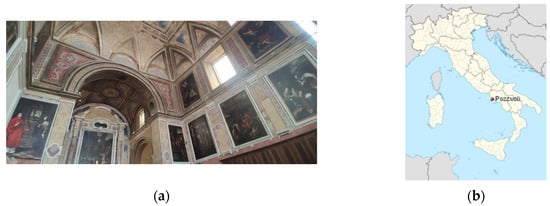
Figure 1
Highly Accessed Articles
Latest Books
E-Mail Alert
News
Topics

Conferences
Special Issues
Special Issue in
QuBS
Quantum Beam and Its Applications for Quantum Technologies
Guest Editor: Takeshi OhshimaDeadline: 31 May 2024
Special Issue in
QuBS
Quantum Effect in Interaction between Femtosecond Pulse and Matters
Guest Editor: Suyu LiDeadline: 30 June 2024
Special Issue in
QuBS
Laser Assisted Manufacturing
Guest Editors: Swee Leong Sing, Wai Yee YeongDeadline: 31 July 2024
Special Issue in
QuBS
Modification of Materials by Using Energetic Ion/Electron Beams
Guest Editor: Alexey N. SokolovskiyDeadline: 31 August 2024



